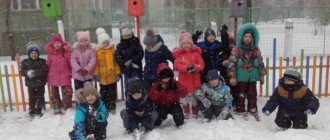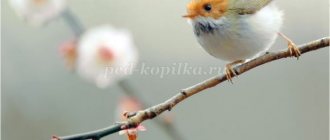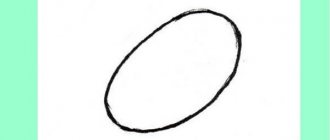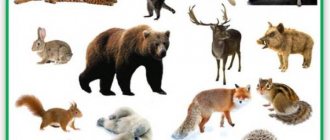Abstract of the GCD on the topic “Birds are our friends.” Senior group
GCD in the senior group “Birds are our friends”
GOAL: to identify children’s knowledge about birds. Instill a love for nature and cultivate a caring attitude towards it. OBJECTIVES :: generalize children’s knowledge about wintering and migratory birds; teach logically, think, cultivate interest in the inhabitants of nature, the ability to sympathize, empathize with wintering birds, take care of birds - feed them. PRELIMINARY WORK: examination of illustrations;
reading books and stories; asking riddles; observations; conversations; bird drawing, applique, modeling. Progress of the lesson:
Educator: Guys, we have a very interesting lesson today. Say: Sparrows, swifts, penguins, bullfinches, rooks, peacocks, parrots and tits: in one word this is -. (BIRDS) Educator: That's right guys, today we will talk about birds. What birds do you know? What do we call the birds that winter with us? What are the names of the birds that come to us in the spring? How do migratory birds know when it's time to leave? (children express their guesses). Why do you think birds fly away to warmer climes? (children’s statements) Educator: Now stand in a circle and let’s play. The game is called "Migratory - Wintering". I will throw a ball to you and name the bird, and you will say whether it is a migratory bird or a wintering one. (a game is being played). Educator: What time of year is it now? Children: Winter - How do birds live in winter? Children: Hungry birds, insects in hibernation, fruits, berries, grass seeds under the snow. Birds find little food in winter. From morning to evening they look for crumbs of food. Birds' downy, warm, feather coats protect them from cold, but not from hunger Educator : In harsh years, out of ten tits, only one survives during the winter. Nine die of starvation. - It's a pity? Children: very sorry Teacher: - Listen to N. Gribchev’s poem. Well, it’s frosty, well, it’s frosty, Nose out - oh-oh-oh! Even white birches have an icy gray crust. Even squirrels are restless Waiting for warmth They don’t scurry off the branch onto a branch, They don’t climb out of the warmth And a hungry tit quietly cries at the window: “There’s nowhere to warm up and feed, No boogers, no grain. The day smokes in the frosty distance, The nights are cold and dark, I’m freezing, I’m starving, “I won’t live to see spring!” - Guys, who can help the wintering birds? (people) Educator: How can people help the birds? (make feeders, feed the birds.) Educator: You can offer the titmouse a piece of unsalted lard; sparrows, bullfinches - bread crumbs, seeds, cereals, grains. And also, in order to feed the birds, you must follow some rules: 1. The birds must be fed in the same place, preferably at the same time. 2. Birds must be fed daily; You can’t feed it from time to time! Especially in cold weather, birds need food every day in order for them to survive. 3. When feeding, do not litter, pick up trash after yourself. Educator:: Birds protect forests and fields from pests, insects, and birds also predict the weather. There are some folk signs: – If sparrows bathe in water in cold weather, it means warmth; – Bullfinches are chirping under the windows – there will be a thaw; – Tits have moved to a person’s home – the beginning of winter, winter will be snowy and cold.. Tell your moms and dads about the signs. Ask your parents what folk signs about birds they know. Educator: Guys, let's imagine that we are birds . Physical education. It's morning! Stop sleeping! Before you fly, you need to stretch your wings. Up wing, down wing, And now it’s the other way around! (One straight arm is raised, the other is lowered, the arms change with a jerk.) We spread the wings to the sides, and bring the shoulder blades together. (Hands in front of the chest, jerking your arms to the sides.) Bend right and left, And bend back and forth. (Tilts left and right, forward and backward.) On command we squat - One-two-three-four-five. Let's do the exercise. Chur, friends, don't lag behind! (Squats.) Wings to the sides and fly. Educator: you’ve had a rest, now guess the riddles? Who looks at the sidewalk and shouts to us from a branch: “Karr!”? Chop a piece of loaf - It will fly in to eat... (crow) They flew in in a flock of loud birds with a bright red breast. Look outside the window - There on the branches... (bullfinches) Who flaunts on the branch In a yellow festive vest? This little bird And her name is... (titmouse) What kind of bird on the bough In the grove sings: “Ku-ku”? An inconspicuous pestle, And her name is... (cuckoo) Guess what kind of bird: At night she can’t sleep at all, Sleeping grass won’t help, She only falls asleep during the day... (owl) Educator Guys, birds are our friends, we can’t offend them. Tell me, what benefits do birds bring? (children's answers) Educator: How can we help birds in winter? (make a feeder) That's right, you can make feeders. Homework assignment. Make a feeder at home with your parents and bring it to kindergarten. Lesson summary: Birds are our faithful helpers, protectors of our forests, fields, gardens, and vegetable gardens from harmful insects and rodents. We can't do without birds.
We recommend watching:
Summary of GCD for introducing older preschoolers to the work of the poet Fet Summary of plot-based GCD in physical education for children of the senior group Summary of GCD in the senior group of compensatory orientation GCD in kindergarten for older preschoolers
Similar articles:
Summary of GCD in the senior group on the topic “Communication”
Summary of GCD in the senior group of kindergarten on the topic “Relaxation”
Summary of a lesson on cognition in the senior group on the topic “Dairy products”
Summary of a lesson on cognition in the senior group on the topic “Construction professions”
Abstract of educational activities for cognition in the senior group of kindergarten on the topic “Russian folk crafts”
Summary of a lesson in the senior group on the topic “Wintering birds”
— The magpie has a black head and wings. The tail is also black, long and straight as an arrow. Magpies are necessary and useful birds . They save trees from beetles and larvae, they pick up all kinds of garbage with their beaks, like street sweepers.
— The crow is a large bird . The head, beak, throat, wings, tail and legs are black, and the chest and back are gray.
— Crows are omnivorous birds .
— Waxwings have elegant plumage, pinkish-brown in color. The head is decorated with perky silver-pink tufts. And on the wings there are bright red even stripes. Waxwings love ripe rowan and hawthorn berries.
Then the children complete Magpie’s fifth task: “Arrange the birds !”
.
There are posters “Winter Forest”
and
“Winter Hut”
, under them there is a feeder made of cardboard and a tree branch.
Educator. Guys, choose one bird a time, name it and find a place for it in the forest or on a feeding trough, near human habitation.
Sample: “The crossbill lives in the forest, it feeds on the seeds of pine and spruce cones”
.
Educator (talks about why some birds fly closer to humans and human habitation in winter).
Wintering birds feed not only on insects and worms, they eat seeds of various plants, and near people’s homes they find crumbs of bread and cereals, and in the cold season they can do without live food. But in a short winter day, birds do not have time to find food in sufficient quantities, especially in snowstorms, frosts, and also after thaws, when there is an ice crust on the branches of trees and shrubs , and then winter feeding saves them from death. Guys, can you and I help wintering birds ? what is needed for this? (Answers.)
Now let’s get up, turn to the right, take five steps forward, look first up, then to the left, bend over, look into the closet.
Children complete Magpie’s sixth task: “Find an object!”
.
Find a wooden feeder and a tray with prepared food for birds : rose hips, unsalted lard, millet, seeds, white bread, oats, etc.
The teacher (together with the children says what is on the tray)
. Here there is food for every taste: soft bread crumbs, hearty, delicious seeds, healthy rolled oats, delicious ripe berries, nutritious, fresh lard.
Children carry the feeder to the table where the bird , and complete Magpie’s seventh task: “Fill the feeder for
wintering birds
. ” They fill the feeder, saying who they want to treat and what.
Sample: “I’ll pour some seeds for the sparrow, because they’re tasty and filling.”
.
Then the children complete Magpie’s eighth task: “Name the rules for feeding
birds !”
.
They name the rules (the teacher helps if necessary)
: feeders are hung in quiet places on tree branches and
bushes ; fill them every day; during severe frosts and snowfalls, add more food; feeders are regularly cleaned of husks, litter, and snow; Birds are never fed black bread and salted lard.
Summary of an ecology lesson for children 5-6 years old on the topic: “Feathered friends”
Summary of an ecology lesson for children 5-6 years old on the topic: “Feathered friends”
Target
: formation of ecological culture; generalization of the idea of wintering and migratory birds.
Tasks:
Educational:
To clarify children’s knowledge about the characteristics of birds: appearance, habitat, nutrition;
Activate the dictionary on the lexical topic: “Wintering and migratory birds”;
Learn to use possessive adjectives: pigeon, sparrow, etc.
Educational:
To develop skills in caring for birds in winter;
Develop thinking, observation, speech, cognitive interest;
Develop gross motor skills, coordination of speech with movement.
Educational:
Cultivate a caring and attentive attitude towards birds, a desire to help them in winter;
Foster a desire to receive and find new knowledge about birds;
Help maintain positive emotions throughout the lesson.
Priority educational areas
: cognitive-speech and artistic-aesthetic development.
Equipment:
tree models, silhouettes of wintering and migratory birds, illustrations of wintering and migratory birds;
record player. Preliminary work:
conversations, observations, looking at illustrations, reading fiction, creative activity
(modeling, drawing, applique).
Progress of organized educational activities.
1 part
.
Surprise moment
: a crow appears, there is a letter in its beak, with a cry of “kar-kar, trouble, trouble,” it throws the letter and flies away. (“I pick it up” and read the letter: “Dear guys! An old forest man is writing to you. Something bad has happened in our forest! The evil sorceress Vyuzhka drove all the birds out of our forest. And without them it’s very bad. Please help me get them back. In the envelope you You will find tasks, after which the birds will return to the forest, a magic wand and a magic spell in order to quickly find yourself in the autumn forest.”
- Well, guys, let’s help the old forest man return the birds?
Children: yes.
“Then get ready, close your eyes, I’ll wave my magic wand, cast a magic spell, and you and I will find ourselves in the forest:
“Autumn forest, marvelous forest,
Full of fairy tales and miracles,
You, open up to us quickly,
Surprise our children"
I slowly pronounce the “spell”, at this time the junior teacher arranges models of trees.
- Open your eyes.
- What forest did we find ourselves in? Describe it.
Children: autumn, beautiful, etc.
-How beautiful it is in the forest! The forest is dressed in autumn attire. The trees are in autumn decoration. And how quiet it is in the forest, no one disturbs its peace.
“But you really can’t see the birds.” And in order to return them, we need to complete the tasks that the old forest man wrote to us about. And here is the first task: you need to guess the description riddle. And you will help me with this. Let’s just agree that we will listen to the riddles to the end.
Game " Guess the description"
". I explain the rules of the game.
The child comes out, closes his eyes, and puts a woodpecker cap on his head.
Who can tell us what you know about this bird? If there is not enough information, I ask another child or add it myself.
Child: this bird lives in the forest. You can call him handsome. His back is black, his belly is white with black specks, and on his head there is a bright red spot, like a beret. She has a very strong beak. With its strong beak it can make a hole in a solid tree trunk. And its tongue is long, penetrates into a gap in the bark and deftly takes out beetles - bark beetles and other insects. He feeds on them.
Child: he is called the forest orderly because he saves the tree from bark beetles and other harmful insects.
Child: he also eats seeds from pine and fir cones.
- Well, did you guess who it is?
Child: woodpecker.
- And then the woodpecker flew in and sat on the tree.
Next, I invite the second child and put on a bullfinch cap.
Child: this bird has black wings and a red breast; the bird got its name because it flies to us with the first snow.
Child: these birds feed on rowan berries, sea buckthorn, barberry, and plant seeds.
-Who is this bird?
Child: bullfinch.
- That's right, so the bullfinch flew in and sat on a branch
I also ask the next child to close his eyes and put on a tit’s cap.
-Who will tell us about this bird?
Child: This is a wintering bird and has a yellow breast. They are very nimble and lively birds; they survive the winter, hiding in a hollow. In spring and summer they feed on various insects, but in winter, when there is not enough food in the forest, the birds have a hard time. In search of food, they fly to human habitation.
Child: tits, in addition to seeds, like to peck fresh, unsalted lard.
Well, guess what kind of bird this is?
Child: tit.
- And then a tit flew in and sat on a tree.
- And the last bird must be described.
I put a magpie cap on the child’s head.
- Who will tell us about this bird? Child: This bird is a white-sided long-tailed fidget. She is very curious. He sees something shiny - a coin or a piece of glass, and looks at it with his round eye. Then he will grab you and drag you into his nest. They are omnivorous birds.
-What kind of bird is this?
Child: forty.
- Look what a lively flock has settled on the tree. The birds in this flock are different, but they all belong to what kind of birds, what can you call them in one word?
Children: Wintering.
- Guys, now I’ll turn you into birds. (I quickly distribute bird silhouettes to each child)
Fizminutka
The bird fluttered its wings,
The bird flapped its wings,
Waved, flew,
She sat down and pecked the grains.
Game "At the feeding trough".
- You have the silhouette of a bird in your hands, look, remember what kind of bird it is and listen carefully to the poem. The bird that hears about itself “flies” to the “feeder”. (Children attach the bird to the magnetic board.)
— Poem by Zinaida Alexandrova “New Dining Room”:
We made a feeding trough, We opened a dining room. On the first day of the week, tits came to visit us. And on Tuesday, look, the bullfinches arrived.
Three crows were there on Wednesday, We weren't expecting them for lunch. And on Thursday from all over the world - a flock of greedy sparrows.
On Friday, in our dining room, Golub enjoyed porridge. And on Saturday seven forty flew into the pie.
On Sunday, on Sunday, a spring guest flew to us - the starling traveler... That’s the end of the song.
- Guys, what bird do you think is the odd one out here?
Children: starling.
- Right, why?
Children: the starling is a migratory bird.
— What other migratory birds do you know?
The children name and I show pictures: cuckoo, swallow, nightingale, rook.
- Why didn’t these birds stay with us for the winter?
Children: Birds that fly away from us for the winter eat various insects: beetles, flies, midges...
— That’s right, when it gets cold and insects hide in cracks, climb deep under the bark, birds can’t reach them, so they fly away from us to warmer climes, where it’s warm and there’s plenty of food.
- So, we have completed the first task, but there is another task in the envelope: d/i “ Guess the bird from the photo”
". If you can do it, the whole flock of birds will delight us with their singing.
I hand out pictures of parts of a bird to the children, explain that the photographer took unsuccessful photographs and they need to guess what kind of bird the photographer photographed. I ask: whose tail? (Lastochkin), etc.
- Now we have completed the second task. Listen, guys, the birds came to life and began to sing (the recording “Sounds of Birds” is playing).
Part 2.
-Guys, let's make the wintering birds happy and make a tasty treat for them.
Children approach the tables on which there are pine cones, birdseed, and paste in jars on trays. I show you a sample of the task. Next, the children make their own treats for the birds. Dip the cones into the paste, and then into the food and place them on a tray.
- What a great fellow you are, how many delicious treats you were able to make for the birds. During our walk, we will hang our treats on branches and delight the birds.
Reflection
.
— Guys, what did you like most about our lesson? What new did you learn? What was difficult for you? What will you talk about at home?
- Our lesson is over, well done everyone.






